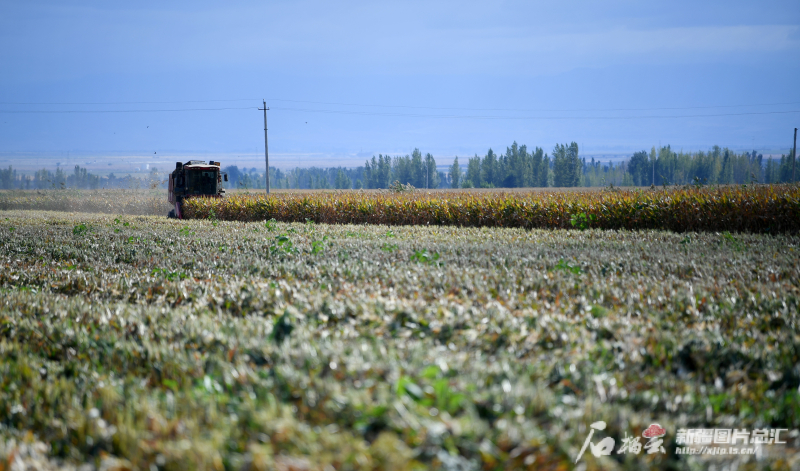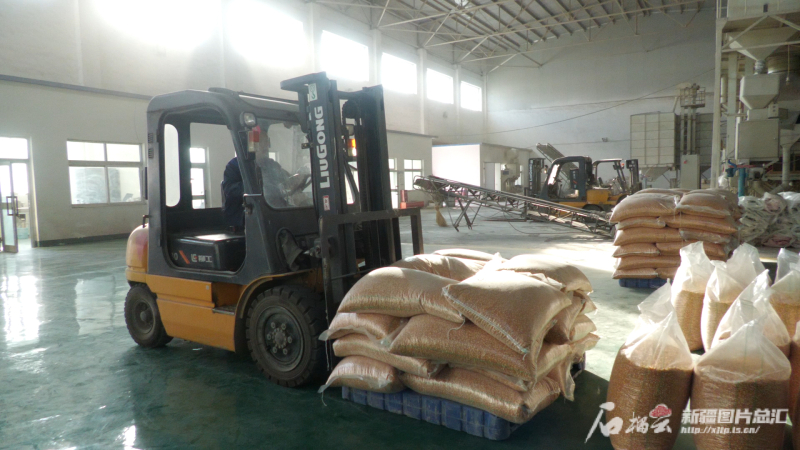Shiliuyun-Xinjiang Daily (Reporter Rayda) news: Out of every 100 corn seeds produced nationwide, 20 originate from the Ili Valley, northwest China's Xinjiang Uygur Autonomous Region.
In 2024, the cultivated area for seed corn production in the Ili Kazak Autonomous Prefecture reached 614,400 mu (about 40,960 hectares), accounting for 52 percent of the total seed corn cultivation area across 14 prefectures and cities in China’s Xinjiang. Together with the 263,300 mu (about 17,553.33 hectares) in Cocodala City, the seed corn cultivation area in the Ili Valley amounted to 877,700 mu (about 58,513.33 hectares), further cementing its position as the largest seed corn base in Xinjiang and the second largest in China. Currently, the annual production of seed corn in the Ili Valley exceeds 400,000 tonnes, with a production value surpassing 3.5 billion yuan (about 476.20 million U.S. dollars).
Effective superposition of advantages boosts development
"The growth environment requirements for seed corn encompass multiple aspects such as temperature, light, moisture, soil, and the Ili Kazak Autonomous Prefecture meets all these requirements for seed corn cultivation," said Sun Chuanqiao, director of the Seed Management Station of the Ili Kazak Autonomous Prefecture.
Located in the northwest of China’s Xinjiang, at the western section of the northern foothills of the Tianshan Mountains, the Ili Kazak Autonomous Prefecture has a temperate continental climate and is renowned as the "Western Granary of Xinjiang." The area enjoys abundant sunlight and heat, with annual sunshine duration exceeding 2,870 hours and an annual average temperature of 10.4°C. This results in strong photosynthesis and abundant water resources. As an important water source, the Ili River has an extensive basin area, with an average annual surface water runoff accounting for about 20 percent of Xinjiang's total water resources, providing ample and high-quality water for agricultural irrigation.
"The accumulated temperature in different regions of the Ili Valley exhibits a graded distribution, capable of meeting the growth requirements of various types of corn varieties, from late-maturing types that need a lot of heat to early-maturing ones that thrive in cooler climates," said Sun Chuanqiao. These conditions enable diversified production of seed corn, providing abundant product resources for building the 'Golden Valley.'"

File photo taken on September 26, 2024 shows a corn harvester works in the cornfields of Anbatie Village in Aixinseli Town, Qapqal Xibe Autonomous County, Ili Kazak Autonomous Prefecture, northwest China’s Xinjiang Uygur Autonomous Region. (Photo by Shiliuyun - Xinjiang Daily/Zou Yi)
For seed corn production, superior natural conditions alone are far from sufficient. Another essential requirement is high-standard farmland.
In recent years, Ili Kazak Autonomous Prefecture has vigorously promoted the construction of high-standard farmland with water-saving drip irrigation as its core, continuously carrying out initiatives such as "combining small fields into large fields," "converting dry farmland to drip irrigation," and "diverting water to the mountains."
Today, the farmland in the Ili Valley has undergone a quiet transformation, with a significant reduction in fragmented field plots. Large-scale, high-quality, centralized, and contiguous farmland suitable for the development requirements of modern agriculture continues to emerge.
The Yuanliheng Agricultural Machinery and Agricultural Comprehensive Development Cooperative in Tielehala Village, Biestuobie Township, Xinyuan County, Ili Kazak Autonomous Prefecture of China’s Xinjiang, focuses on the development of the seed corn industry. In 2024, the Cooperative contracted 50,000 mu (about 3333 hectares) of land at a price of 1550 yuan per mu. In this township, 23 percent of the agricultural labor force cultivates 90.83 percent of the land, fully leveraging the advantage of a small number of people farming a large amount of land. Over 6900 farmers and herdsmen who have been relieved from farming earn income from two channels, i.e., land transfer payments and wages from working outside, or have started their own businesses.
In 2024, Ili Kazak Autonomous Prefecture newly constructed 875,400 mu (about 58,360 hectares) of high-standard farmland and has implemented a "dryland to drip irrigation" conversion project covering a cumulative area of 403,300 mu (about 26,887 hectares). As of now, the total area of high-standard farmland directly under the Ili Kazak Autonomous Prefecture has reached 6,036,900 mu (about 402,460 hectares).
Industrial convergence shows strong attraction
Recently, in the processing workshop of the Ili Branch of Shandong Denghai Seed Industry Co., Ltd., located in Gongliu County, the commercial seed processing line was operating at full speed. Grain by grain, golden yellow seeds underwent processes such as selection and coating before entering the packaging stage. This batch of corn seeds will be successively shipped to other provinces and cities across the country.

Photo taken on January 2, 2025 shows a worker from the Ili Branch of Shandong Denghai Seed Industry Co., Ltd. drives a forklift to transport seed corn to the packaging production line. (Photo by Lyu Jiaqi)
"We have identified the unique advantages of the Ili Valley for developing the seed corn industry," said Xu Fusheng, manager of the Ili Branch of Shandong Denghai Seed Industry Co., Ltd. Initially, the company engaged in seed multiplication in Gongliu County by providing certified seeds to farmers for cultivation and then repurchasing them. During this process, the company was gradually attracted by the advantageous resources of Ili Kazak Autonomous Prefecture, prompting it to travel thousands of miles to invest and establish a factory, thereby developing the seed corn industry chain.
Today, fine packaged seeds have abandoned the traditional production and sales model of bulk transportation in large trucks and packaging in jute bags. Instead, they have truly achieved scientific breeding, large-scale cultivation, order-based production, careful processing, electronic sales, and fast delivery. The products are sold far and wide across the country.
Currently, there are 30 seed enterprises directly under the Ili Kazak Autonomous Prefecture, with 11 of them having registered capital exceeding 50 million yuan (about 6.80 million U.S. dollars). There are already 156 enterprises, of which headquarters are based in or outside Xinjiang, engaged in seed production in the Ili Kazak Autonomous Prefecture. Additionally, service enterprises and industry chain-related enterprises such as smart agricultural services and processing of corn cobs and other seed production waste have been introduced, promoting the extension and networking of the seed industry chain.
With the establishment of factories by leading enterprises, the facilities and equipment for seed processing have seen a leap in quality. In 2024, the Ili Kazak Autonomous Prefecture directly built 10 new corn ear drying lines and 16 packaging lines, which can currently meet the drying needs for more than 800,000 mu (about 53,340 hectares) of seed corn.
"The seed industry in Ili Kazak Autonomous Prefecture is developing rapidly with vast prospects, which is the reason why our company invested 238 million yuan (about 32.39 million U.S. dollars) to build a factory here," said Zhang Haijun, the operations manager of China Seed Group Xinjiang Seed Industry Co., Ltd. The company officially commenced operations in August 2024. The decision to locate in Ili was based on both the excellent natural conditions here and the strong support from the local government, which places great importance on the development of the seed industry. Over the past few years, the corn seed production industry in Ili Kazak Autonomous Prefecture has flourished, and in just a short period of time, it has occupied an important position in the development of the corn seed industry nationwide. The company is confident in making this industry bigger and stronger.
Technology helps to reach new heights
"In 2024, I planted 6,400 mu (about 426.7 hectares) of seed corn with an average yield of 580 kilograms per mu. I signed a contract with a company and earned about 900 yuan per mu. And thanks to using smart farming, I'm now making an extra 500 yuan profit per mu because I'm earning more and saving on costs," Jia Ruijie, a large-scale farmer from Xiawenyar Village, Wenyar Town, Yining County of Ili Kazak Autonomous Prefecture, recently calculated his income from last year for reporters.
Jia Ruijie has been engaged in agricultural production since 2015. In 2023, he began planting seed corn and invested 3 million yuan (about 408,278.61 U.S. dollars) to introduce smart agriculture big data technology. Starting from sowing, he analyzed the land and conducted continuous monitoring through satellite remote sensing to keep abreast of crop growth. He implemented differentiated and tiered water and fertilizer integration management. During the tasseling stage of seed corn, he monitored tassel quality through drones, enabling full traceability online throughout the process.
"Over the past few years, there has been an increase in the cultivated area of seed corn and the number of seed enterprises in Ili Kazak Autonomous Prefecture. For us farmers, this has led to higher planting requirements and seed quality. We need to quickly adapt and continuously try out new technologies to contribute to the development of the seed industry," said Jia Ruijie. In recent years, agricultural experts and technicians have been continuously training farmers to ensure that every corn seed is of the best quality.
The rise of an industry often serves as a powerful engine for driving local economic development and boosting farmers' income. This year, land transfer for seed corn production in Ili Kazak Autonomous Prefecture has increased farmers' income by 218 million yuan (about 29.67 million U.S. dollars). The seed production industry has also created employment opportunities for more than 1.5 million person-times in the surrounding areas, adding more than 390 million yuan (about 53.08 million U.S. dollars) to workers' income.
From one individual to a village, from one town to a county, and then to the entire prefecture, the enthusiasm for the development of the seed production industry is now pervasive throughout Ili Kazak Autonomous Prefecture.
In the next step, Ili Kazak Autonomous Prefecture will take the Ili River Valley's golden corn belt as its core area and actively promote Qapqal Xibe Autonomous County, Yining County, Xinyuan County, and Huocheng County to apply for national-level recognition as major seed production counties, striving to establish a national-level corn seed production base. Additionally, Ili Kazak Autonomous Prefecture aims to build a western seed industry cooperation and exchange center that serves the whole country and faces Central Asia. This will be a comprehensive platform integrating the research and exhibition of new varieties and technologies, seed industry information exchange, international cooperation negotiations, and other functions.
(A written permission shall be obtained for reprinting, excerpting, copying and mirroring of the contents published on this website. Unauthorized aforementioned act shall be deemed an infringement, of which the actor shall be held accountable under the law.)









